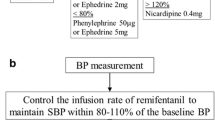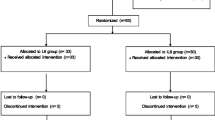Abstract
Purpose
This study aimed to investigate the efficacy of the ClearSight™ system (Edwards Lifesciences, Irvine, CA) for reducing the incidence of hypotension compared with the traditional oscillometric blood pressure monitoring in cesarean delivery under spinal anesthesia.
Methods
Forty patients undergoing cesarean delivery under spinal anesthesia were enrolled. The patients were randomly divided into two groups (Control and ClearSight groups). All patients received spinal anesthesia using 0.5% hyperbaric bupivacaine (11.5 mg) and fentanyl (10 µg). Blood pressure was managed with the same protocol using the ClearSight™ system (ClearSight group) and oscillometric blood pressure monitoring (Control group). Furthermore, we compared the accuracy of the ClearSight™ system with the traditional oscillometric monitoring for blood pressure measurement using Bland–Altman, four-quadrant plot, and polar plot analyses.
Results
The incidence of hypotension was significantly lower in the ClearSight group from induction to delivery (45% vs. 0%, p < 0.001) and to the end of surgery (50% vs. 20%, p = 0.049). Intraoperative nausea occurred more frequently in the Control group (45% vs. 10%, p = 0.012). The ClearSight™ system demonstrated acceptable accuracy with a bias of − 4.3 ± 11.7 mmHg throughout the procedure. Four-quadrant analysis revealed an excellent trending ability of the ClearSight™ system with a concordance rate of approximately 95%. In the polar plot analysis, the angular bias and concordance rate were − 13.5° ± 19.0° and 76.9%, respectively.
Conclusions
The accuracy and trending ability of the ClearSight™ system for blood pressure measurement was clinically acceptable in cesarean delivery under spinal anesthesia, leading to reductions in maternal hypotension and nausea.






Similar content being viewed by others
References
Klohr S, Roth R, Hofmann T, Rossaint R, Heesen M. Definitions of hypotension after spinal anaesthesia for caesarean section: literature search and application to parturients. Acta Anaesthesiol Scand. 2010;54:909–21.
Ngan Kee WD, Khaw KS. Vasopressors in obstetrics: what should we be using? Curr Opin Anaesthesiol. 2006;19:238–43.
Sng BL, Wang H, Assam PN, Sia AT. Assessment of an updated double-vasopressor automated system using Nexfin for the maintenance of haemodynamic stability to improve peri-operative outcome during spinal anaesthesia for caesarean section. Anaesthesia. 2015;70:691–8.
Auroy Y, Benhamou D, Bargues L, Ecoffey C, Falissard B, Mercier FJ, Bouaziz H, Samii K. Major complications of regional anesthesia in France: the SOS regional anesthesia hotline service. Anesthesiology. 2002;97:1274–80.
Hawkins JL, Chang J, Palmer SK, Gibbs CP, Callaghan WM. Anesthesia-related maternal mortality in the United States: 1979–2002. Obstet Gynecol. 2011;117:69–74.
Butwick AJ, Columb MO, Carvalho B. Preventing spinal hypotension during caesarean delivery: what is the latest? Br J Anaesth. 2015;114:183–6.
Kinsella SM, Carvalho B, Dyer RA, Fernando R, McDonnell N, Mercier FJ, Palanisamy A, Sia ATH, Van de Velde M, Vercueil A. International consensus statement on the management of hypotension with vasopressors during caesarean section under spinal anaesthesia. Anaesthesia. 2018;73:71–92.
Bartels K, Esper SA, Thiele RH. Blood pressure monitoring for the anesthesiologist: a practical review. Anesth Analg. 2016;122:1866–79.
Tsuchiya M, Takahashi R, Furukawa A, Suehiro K, Mizutani K, Nishikawa K. Transversus abdominis plane block in combination with general anesthesia provides better intraoperative hemodynamic control and quicker recovery than general anesthesia alone in high-risk abdominal surgery patients. Minerva Anestesiol. 2012;78:1241–7.
Bland JM, Altman DG. Statistical methods for assessing agreement between two methods of clinical measurement. Lancet. 1986;1:307–10.
Myles PS, Cui J. Using the Bland–Altman method to measure agreement with repeated measures. Br J Anaesth. 2007;99:309–11.
Kim SH, Lilot M, Sidhu KS, Rinehart J, Yu Z, Canales C, Cannesson M. Accuracy and precision of continuous noninvasive arterial pressure monitoring compared with invasive arterial pressure: a systematic review and meta-analysis. Anesthesiology. 2014;120:1080–97.
Critchley LA, Yang XX, Lee A. Assessment of trending ability of cardiac output monitors by polar plot methodology. J Cardiothorac Vasc Anesth. 2011;25:536–46.
Suehiro K, Tanaka K, Yamada T, Matsuura T, Funao T, Mori T, Nishikawa K. The utility of intra-operative three-dimensional transoesophageal echocardiography for dynamic measurement of stroke volume. Anaesthesia. 2015;70:150–9.
Suehiro K, Tanaka K, Yamada T, Matsuura T, Mori T, Funao T, Nishikawa K. The ability of the Vigileo-FloTrac system to measure cardiac output and track cardiac output changes during one-lung ventilation. J Clin Monit Comput. 2015;29:333–9.
Okudaira S, Suzuki S. Influence of spinal hypotension on fetal oxidative status during elective cesarean section in uncomplicated pregnancies. Arch Gynecol Obstet. 2005;271:292–5.
Mercier FJ, Diemunsch P, Ducloy-Bouthors AS, Mignon A, Fischler M, Malinovsky JM, Bolandard F, Aya AG, Raucoules-Aime M, Chassard D, Keita H, Rigouzzo A, Le Gouez A, Group CW. 6% hydroxyethyl starch (130/0.4) vs Ringer’s lactate preloading before spinal anaesthesia for caesarean delivery: the randomized, double-blind, multicentre CAESAR trial. Br J Anaesth. 2014;113:459–67.
Matsota P, Karakosta A, Pandazi A, Niokou D, Christodoulaki K, Kostopanagiotou G. The effect of 0.5 L 6% hydroxyethyl starch 130/0.42 versus 1 L Ringer’s lactate preload on the hemodynamic status of parturients undergoing spinal anesthesia for elective cesarean delivery using arterial pulse contour analysis. J Anesth. 2015;29:352–9.
Ngan Kee WD, Khaw KS, Lee BB, Lau TK, Gin T. A dose-response study of prophylactic intravenous ephedrine for the prevention of hypotension during spinal anesthesia for cesarean delivery. Anesth Analg. 2000;90:1390–5.
van Bogaert LJ. Prevention of post-spinal hypotension at elective cesarean section by wrapping of the lower limbs. Int J Gynaecol Obstet. 1998;61:233–8.
Miyabe M, Sato S. The effect of head-down tilt position on arterial blood pressure after spinal anesthesia for cesarean delivery. Reg Anesth. 1997;22:239–42.
Qian XW, Chen XZ, Li DB. Low-dose ropivacaine-sufentanil spinal anaesthesia for caesarean delivery: a randomised trial. Int J Obstet Anesth. 2008;17:309–14.
Latson TW, Ashmore TH, Reinhart DJ, Klein KW, Giesecke AH. Autonomic reflex dysfunction in patients presenting for elective surgery is associated with hypotension after anesthesia induction. Anesthesiology. 1994;80:326–37.
Lonjaret L, Lairez O, Minville V, Geeraerts T. Optimal perioperative management of arterial blood pressure. Integr Blood Press Control. 2014;7:49–59.
Lin FQ, Li C, Zhang LJ, Fu SK, Chen GQ, Yang XH, Zhu CY, Li Q. Effect of rapid plasma volume expansion during anesthesia induction on haemodynamics and oxygen balance in patients undergoing gastrointestinal surgery. Int J Med Sci. 2013;10:355–61.
Hirose N, Kondo Y, Maeda T, Suzuki T, Yoshino A. Relationship between regional cerebral blood volume and oxygenation and blood pressure during spinal anesthesia in women undergoing cesarean section. J Anesth. 2016;30:603–9.
Meidert AS, Nold JS, Hornung R, Paulus AC, Zwißler B, Czerner S. The impact of continuous non-invasive arterial blood pressure monitoring on blood pressure stability during general anaesthesia in orthopaedic patients: a randomised trial. Eur J Anaesthesiol. 2017;34:716–22.
Ilies C, Kiskalt H, Siedenhans D, Meybohm P, Steinfath M, Bein B, Hanss R. Detection of hypotension during Caesarean section with continuous non-invasive arterial pressure device or intermittent oscillometric arterial pressure measurement. Br J Anaesth. 2012;109:413–9.
Akkermans J, Diepeveen M, Ganzevoort W, van Montfrans GA, Westerhof BE, Wolf H. Continuous non-invasive blood pressure monitoring, a validation study of Nexfin in a pregnant population. Hypertens Pregnancy. 2009;28:230–42.
Chen G, Chung E, Meng L, Alexander B, Vu T, Rinehart J, Cannesson M. Impact of non invasive and beat-to-beat arterial pressure monitoring on intraoperative hemodynamic management. J Clin Monit Comput. 2012;26:133–40.
Funding
Only departmental funds were used for this study.
Author information
Authors and Affiliations
Corresponding author
Ethics declarations
Conflict of interest
K. S. has received a speaker fee from Edwards LifeSciences in the 5th annual meeting of Japanese Society of Regional Anesthesia (held on 4/13/2018, Osaka, Japan).
About this article
Cite this article
Juri, T., Suehiro, K., Kimura, A. et al. Impact of non-invasive continuous blood pressure monitoring on maternal hypotension during cesarean delivery: a randomized-controlled study. J Anesth 32, 822–830 (2018). https://doi.org/10.1007/s00540-018-2560-2
Received:
Accepted:
Published:
Issue Date:
DOI: https://doi.org/10.1007/s00540-018-2560-2




